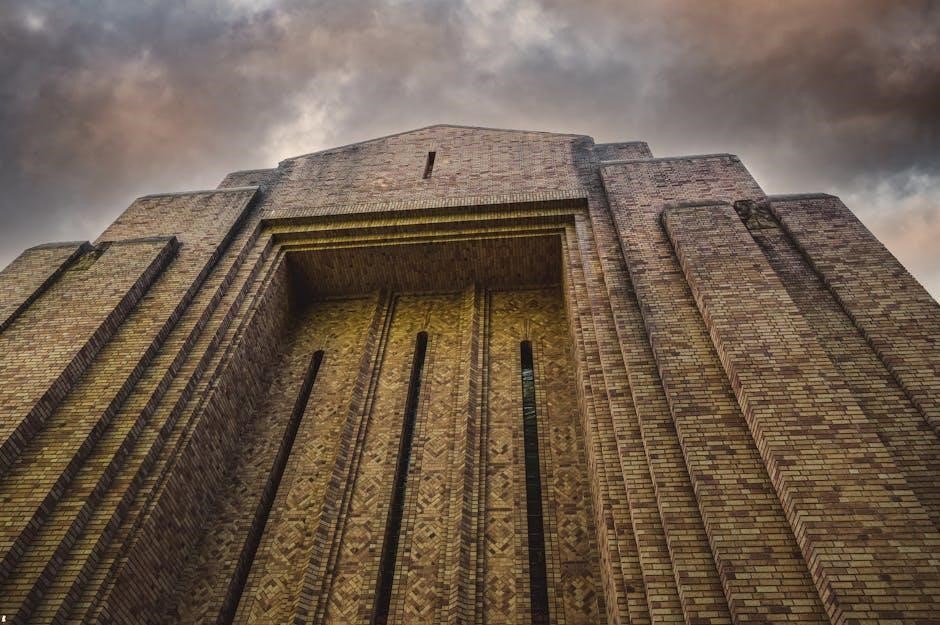The Grand Princess deck plans PDF offers a detailed guide to the ship’s layout, featuring stateroom categories, dining venues, entertainment options, and amenities for a seamless cruise experience.
1.1 Overview of the Grand Princess Cruise Ship
The Grand Princess is a spectacular floating palace offering luxurious cruises across the globe. With its 17 decks, the ship features a wide range of amenities, including dining venues, entertainment options, and recreational facilities. The vessel is designed to accommodate diverse traveler needs, from family-friendly staterooms to luxurious suites. Its deck plans, available in PDF format, provide a detailed layout of cabins, pools, spas, and public areas, ensuring passengers can plan their cruise seamlessly. The Grand Princess is renowned for its elegance and extensive onboard offerings.
1.2 Importance of Deck Plans for Cruise Planning
Deck plans are essential for effective cruise planning, allowing passengers to familiarize themselves with the ship’s layout. They provide detailed information about cabin locations, dining venues, entertainment options, and recreational facilities. By reviewing the Grand Princess deck plans PDF, travelers can plan their itinerary, locate amenities, and make informed decisions about cabin selection. This ensures a smooth and enjoyable experience, helping passengers maximize their time onboard and make the most of their cruise.

Deck-by-Deck Layout of Grand Princess

The Grand Princess deck plans PDF provides a comprehensive guide to the ship’s layout, showcasing cabin locations, amenities, and ship features across all decks for efficient cruise planning.
2.1 Sky Deck (17/18) – Features and Amenities
The Sky Deck (17/18) on the Grand Princess is a hub for entertainment and relaxation. It features the iconic Skywalkers Nightclub, offering stunning ocean views and vibrant nightlife. The deck also provides panoramic vistas, perfect for taking in the surroundings during sailaways or sunset. With its elevated position, it’s a prime spot for photography and enjoying fresh sea air. The Sky Deck combines leisure and entertainment, making it a popular destination for passengers seeking both relaxation and lively activities aboard the Grand Princess.
2.2 Sports Deck (16) – Facilities and Activities
The Sports Deck (16) on the Grand Princess is designed for active passengers, offering a variety of recreational facilities. It features a sports court for basketball, tennis, and other games, as well as a golf simulator for those looking to refine their swing. Additionally, the deck includes a jogging track and fitness areas, perfect for staying active while enjoying the ocean breeze. These amenities cater to fitness enthusiasts and families alike, ensuring a fun and energetic experience aboard the ship.
2.3 Sun Deck (15) – Pool Areas and Recreation
The Sun Deck (15) on the Grand Princess is a hub for relaxation and recreation. It features a large main pool surrounded by sun loungers and shaded areas, perfect for soaking up the sun. Additionally, the deck offers whirlpool spas and a retreat pool for adults seeking tranquility. Recreation options include trivia games and live music, creating a lively atmosphere. The deck also provides family-friendly spaces, making it a central spot for both relaxation and fun during your cruise.
2.4 Lido Deck (14) – Dining and Entertainment Options
Lido Deck (14) is a vibrant hub for dining and entertainment on the Grand Princess. It features the Horizon Court, a spacious buffet offering international cuisine with live cooking stations. The deck also includes the Poolside Grill and Pizzeria, serving casual favorites. Entertainment options abound, with Calypso Reef and Neptune’s Reef pools, perfect for lounging. Live music and activities like trivia games add to the lively atmosphere, making Lido Deck a central spot for both dining and leisure during your cruise.
2.5 Aloha Deck (12) – Staterooms and Suites
Aloha Deck (12) offers a variety of staterooms and suites, catering to diverse preferences. It features family suites with interconnecting rooms, accommodating up to eight guests, and mini-suites with private balconies. Standard staterooms include oceanview and interior options, providing comfortable living spaces. All accommodations are equipped with modern amenities, such as flat-screen TVs, mini-fridges, and spacious closets. The deck’s central location ensures easy access to dining, entertainment, and public areas, making it a convenient choice for travelers seeking comfort and accessibility during their cruise.
2.6 Baja Deck (11) – Cabin Categories and Layouts
Baja Deck (11) offers a diverse range of cabin categories, including mini-suites, balcony staterooms, oceanview, and interior rooms. Mini-suites feature private balconies and spacious living areas, while balcony staterooms provide stunning ocean views. Oceanview cabins offer large windows for natural light, and interior rooms are cozy and budget-friendly. Family-friendly accommodations are also available, with interconnecting staterooms for larger groups. The deck’s layout ensures easy access to public areas, making it a popular choice for travelers seeking comfort and convenience during their voyage.
2.7 Caribe Deck (10) – Balcony Staterooms and Views

Caribe Deck (10) is renowned for its balcony staterooms, offering breathtaking ocean views. These staterooms feature private balconies with unobstructed vistas, perfect for scenic cruising. The deck includes a mix of standard balcony rooms and mini-suites, providing ample space for relaxation. Staterooms are equipped with comfortable furnishings and modern amenities. The views are considered unobstructed unless specified, with obstructions typically limited to minor ship hardware. This deck is a favorite among travelers seeking both comfort and stunning natural scenery during their voyage.
2.8 Dolphin Deck (9) – Family-Friendly Accommodations
Dolphin Deck (9) is designed with families in mind, offering family-friendly accommodations that cater to all ages. The deck features interconnecting staterooms and family suites, which can accommodate up to eight people. These spacious rooms provide comfort and convenience for larger groups. Private balconies offer stunning ocean views, while proximity to kids’ clubs and entertainment venues makes it ideal for families. The deck’s layout ensures easy access to recreational activities, creating a welcoming environment for family vacations at sea.
2.9 Emerald Deck (8) – Promenade and Public Areas
Emerald Deck (8) is a hub of activity, featuring a spacious promenade perfect for strolling and taking in ocean views. The deck is home to popular public areas like Crooners Bar and Leaves Tea Library, offering relaxation and entertainment. Passengers can enjoy convenient access to Future Cruise and Shore Excursions services. The deck’s central location makes it a great spot to unwind or plan the next adventure, with amenities designed to enhance the overall cruise experience for all travelers.
2.10 Promenade Deck (7) – Entertainment and Dining Venues
Promenade Deck (7) is a vibrant hub of entertainment and dining, featuring the elegant Michelangelo Dining Room for fine dining experiences. The deck also hosts the Explorers Lounge, offering live music and performances, and the Grand Casino & Bar, where guests can enjoy gaming and cocktails. These venues provide a variety of options for passengers to unwind, socialize, and indulge in culinary delights, making Promenade Deck a central spot for evening entertainment and relaxation aboard the Grand Princess.
2.11 Fiesta Deck (6) – Nightlife and Leisure Activities
Fiesta Deck (6) is a lively destination for nightlife and leisure, featuring the popular Crooners Bar where guests can enjoy live music and cocktails. The deck also includes The Shops of Princess, offering retail therapy, and various entertainment spots for relaxation and socializing. With its vibrant atmosphere, Fiesta Deck provides a perfect setting for passengers to unwind, shop, and experience the ship’s dynamic nightlife, making it a central hub for evening activities aboard the Grand Princess.
2.12 Plaza Deck (5) – Shops and Services
Plaza Deck (5) is a hub for shopping and services, featuring The Shops of Princess, which offer a variety of retail outlets selling everything from souvenirs to luxury items. Guests can also access services like Future Cruise and Shore Excursions to plan their next adventure. Additionally, the deck is home to Guest Services and the Grand Casino & Bar, providing entertainment and assistance all in one convenient location. Plaza Deck is a must-visit for both shopping enthusiasts and those seeking onboard amenities.
2.13 Gala Deck (4) – Specialty Restaurants and Bars
Gala Deck (4) is renowned for its exceptional dining and entertainment options. It features the Crown Grill, a specialty restaurant offering premium steaks and seafood. Additionally, the deck is home to Crooners Bar, a lively spot for cocktails and live music, and Tea Leaves & Library, perfect for a relaxing tea experience. These venues provide a sophisticated atmosphere, catering to diverse tastes and preferences, making Gala Deck a focal point for culinary and social experiences aboard the Grand Princess.
Key Amenities and Services on Grand Princess
Grand Princess offers a wide range of amenities, including dining venues, entertainment options, wellness facilities, shopping areas, and family-friendly activities, ensuring a memorable cruise experience for all passengers.
3.1 Dining Options – Restaurants and Specialty Venues
Grand Princess features an array of dining options, including the Crown Grill, Michelangelo Dining Room, and Sabatini’s Italian restaurant. Specialty venues like the Chef’s Table offer exclusive culinary experiences. The ship also boasts casual eateries and themed dining areas, ensuring diverse choices for every palate. From fine dining to relaxed meals, the Grand Princess provides a culinary journey with its extensive selection of restaurants and specialty venues, catering to all tastes and preferences during your voyage.
3.2 Entertainment Venues – Theaters, Lounges, and Bars
Grand Princess offers a vibrant entertainment scene with venues like the Princess Theater, featuring Broadway-style shows, and the Explorers Lounge for live music and comedy acts. Crooners Bar and the Wheelhouse Bar provide intimate settings for cocktails and relaxation. The ship also boasts nightclubs like Skywalkers, ensuring a lively atmosphere for evening entertainment. These diverse spaces cater to various tastes, offering something for everyone to enjoy during their voyage.
3.3 Wellness and Spa Facilities – Pools, Fitness, and Relaxation

Grand Princess features extensive wellness facilities, including the Lotus Spa, offering massages and treatments. The fitness center is equipped with modern equipment for workouts. Multiple pools, such as the Calypso Reef and Neptune’s Reef, provide spaces for swimming and relaxation. Whirlpool spas and a solarium offer serene spots to unwind. These amenities ensure passengers can rejuvenate and maintain their wellness routines while enjoying the luxurious cruise experience.
3.4 Shopping Areas – Retail Outlets and Boutiques
Grand Princess offers a variety of shopping experiences across its decks, including The Shops of Princess, which feature duty-free items, jewelry, and souvenirs. Passengers can explore boutiques like Crooners Bar, Leaves Tea & Library, and Future Cruise. These retail outlets provide a convenient way to shop for essentials, gifts, or luxury items while onboard. The shopping areas are strategically located on decks like Plaza Deck (5), making it easy for guests to enjoy a leisurely shopping experience during their cruise.
3.5 Family-Friendly Amenities – Kids’ Clubs and Activities
Grand Princess offers family-friendly amenities, including kids’ clubs and activities designed for all ages. The ship features youth centers with age-specific programs, ensuring entertainment for children while parents relax. Family suites, such as D105 and D101, accommodate up to eight people, offering private balconies for shared family moments. Additional amenities like game areas and family-friendly pools provide fun for everyone, making Grand Princess an ideal choice for family cruises.
Stateroom Categories and Cabin Layouts
Grand Princess offers a variety of staterooms, from luxurious suites to cozy interior rooms, ensuring comfort and stunning ocean views tailored to every traveler’s preference and budget.
4.1 Suite Categories – Luxury Accommodations
Grand Princess suites offer unparalleled luxury, featuring spacious layouts, private balconies, and elegant décor. These premium accommodations provide separate living areas, whirlpool tubs, and exclusive amenities. With square footage varying based on deck location, suites cater to discerning travelers seeking privacy and comfort. Some suites can accommodate up to eight guests, making them ideal for families or groups. The Grand Princess deck plans PDF highlights these luxurious options, ensuring guests can plan their stay in style and sophistication.
4.2 Mini-Suite Categories – Spacious and Comfortable
Mini-suites on the Grand Princess offer a perfect blend of space and comfort, ideal for travelers seeking a luxurious yet affordable option. These accommodations feature private balconies, separate seating areas, and ample storage. With square footage varying by deck location, mini-suites can accommodate up to four guests, making them suitable for small families or couples. The Grand Princess deck plans PDF provides detailed layouts, helping guests choose their preferred mini-suite for a relaxing and enjoyable cruise experience.
4.3 Balcony Staterooms – Ocean Views and Private Spaces
Grand Princess balcony staterooms offer stunning ocean views and private spaces, perfect for relaxation. Located on decks like Caribe and Dolphin, these staterooms feature private balconies with unobstructed views, as noted in the deck plans PDF. Square footage varies by deck and location, ensuring a comfortable stay. Some balcony staterooms are interconnecting, ideal for families. The view is measured from the balcony railing, with obstructions limited to essential ship hardware, providing a serene experience for guests seeking oceanfront comfort and privacy during their cruise.

4.4 Oceanview and Interior Staterooms – Affordable Options

Grand Princess offers affordable oceanview and interior staterooms, providing comfortable accommodations for budget-conscious travelers. Oceanview staterooms feature large windows with scenic sea views, while interior rooms offer a cozy retreat. Both categories are available on multiple decks, including Emerald and Plaza, with square footage varying by location. These staterooms are ideal for guests prioritizing affordability without compromising on amenities, making them a great choice for families or those seeking a relaxing cruise experience with essential comforts and convenient access to ship amenities.

Downloading the Grand Princess Deck Plan PDF
The Grand Princess deck plan PDF is a comprehensive guide featuring detailed layouts of cabins, amenities, and ship highlights, helping you plan your cruise effortlessly and explore all features.
5.1 How to Access the Official Deck Plan
To access the Grand Princess deck plan PDF, visit the official Princess Cruises website and navigate to the “Deck Plans” section. Use the search function to find the Grand Princess and select the desired voyage dates. Download the PDF, which includes detailed layouts of cabins, amenities, and public areas. This resource helps passengers plan their cruise by exploring stateroom locations, dining venues, entertainment options, and wellness facilities, ensuring a well-organized and enjoyable journey.
5.2 Navigating the PDF for Cruise Planning
The Grand Princess deck plan PDF is designed for easy navigation, with clear deck-by-deck layouts and a legend explaining cabin categories and amenities. Use the color-coded sections to identify stateroom types, dining venues, and entertainment options. Zoom in to view detailed cabin locations, balcony views, and proximity to key facilities. This tool helps passengers plan their cruise efficiently, ensuring they make the most of their time onboard by exploring all available features and services.
Conclusion

The Grand Princess deck plans PDF is an essential tool for planning a memorable cruise, offering detailed insights into staterooms, amenities, and ship highlights to enhance your experience.
6.1 Final Thoughts on Grand Princess Deck Plans
The Grand Princess deck plans PDF is an invaluable resource for cruisers, offering a detailed layout of the ship’s amenities, staterooms, and public areas. It provides clarity on cabin locations, dining venues, and entertainment options, ensuring passengers can plan their journey effectively. Whether you’re seeking luxury suites or budget-friendly options, the deck plan guide helps you navigate the ship with ease. This comprehensive tool enhances your cruise experience, making it a must-have for both first-time and seasoned travelers.










